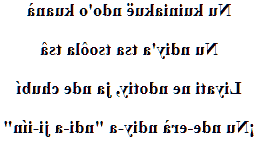Zenzontepec love poem
Nu kuanà
Nu kuiniakuë ndo'o kuanà
Nu ndiy'a tsa tsoôla tsâ
Liyati ne ndotiy, ja nde chubí
¡Nu nde-erà ndiy-a "ndi-a ji-iín"


→ French poem ←
Zenzontepec language
Zenzontepec love poem, an oto-mango language, from the Zapotec group and more precisely one of the six variants of the Chatino (Chatino Occidental Alto, Northern Chatino, Zenzontepec Chatino, Autonym : Cha’ jna’a, Tsá'jnyä) which are : (Western Highland, Eastern Highland, Nopala, Tataltepec, Zacatepec and Zenzontepec).
Of the six dialects, it is certainly the least intelligible with the others, because the Chatino groups which speak it are very isolated.
All the Chatino languages are spoken in the Oaxaca region in Mexico (50,000 people), in a municipality of Sola de Vega and in most of the municipalities of Juquila. This whole region is mountainous, and even if the distances remain small, the different areas remain isolated creating significant diversity, explaining all the variations of chatino.
Zenzontepec is more precisely located near Santa Cruz Zenzontepec and San Jacinto Tlacotepec in the southwest of the state of Oaxaca, and is spoken by about 9,000 people.
The Chatino languages would have started to separate from their Zapotec origin 2,500 years ago.
Chatino people
The Chatinos (peoples useful words) live in the southeast of Oaxaca state in Mexico, in mountainous regions.
Indeed, the Chatino peoples have a long history with their neighbors, the Mixtecs, Zapotecs and Nahua groups.
They had for example, important links with the Zapotecs before separating from them, and when the Spaniards arrived, they were under the domination of the Mixtecs. These periods of domination by their powerful neighbors, will also have made them move to other territories.
Their myths show the importance of the coast where they live, and of the sea, since it is there that these stories tell their origin. One of their original myth even makes them come from an underwater city.
In 1522 Pedro de Alvarado sent by Cortés will be the first Spaniard to come into contact with the Chatinos.
Today, many of them continue to live in fairly traditional ways, making the places where they live prized by tourism.
For many, they remain breeders and cultivators (coffee, beans and of course corn), it is also necessary to cite the cochineals that they produced, from the Spanish time, to get the carmine pigment.
Mazatec - Zapotec - Jñatrjo - Tlapanec - Amuzgo - Dbaku - Coicoyán Mixtec - Southern Puebla Mixtec